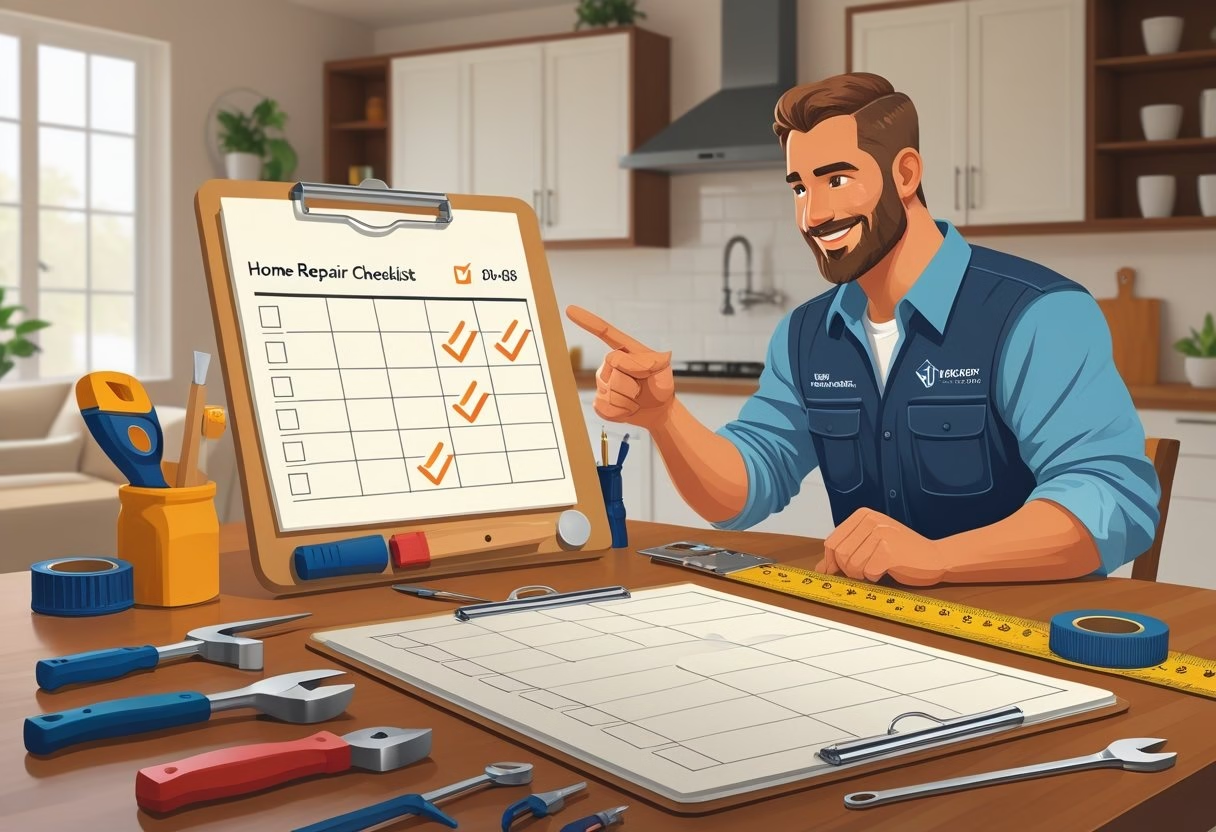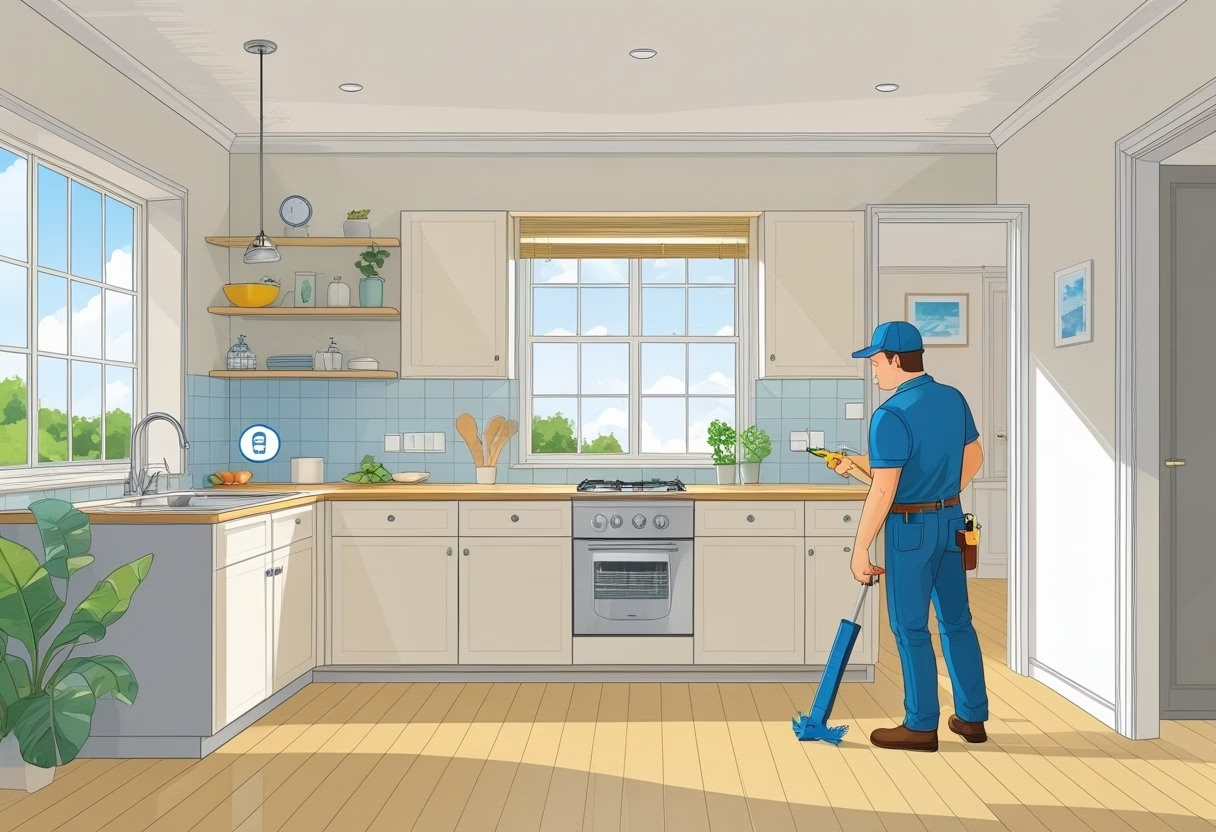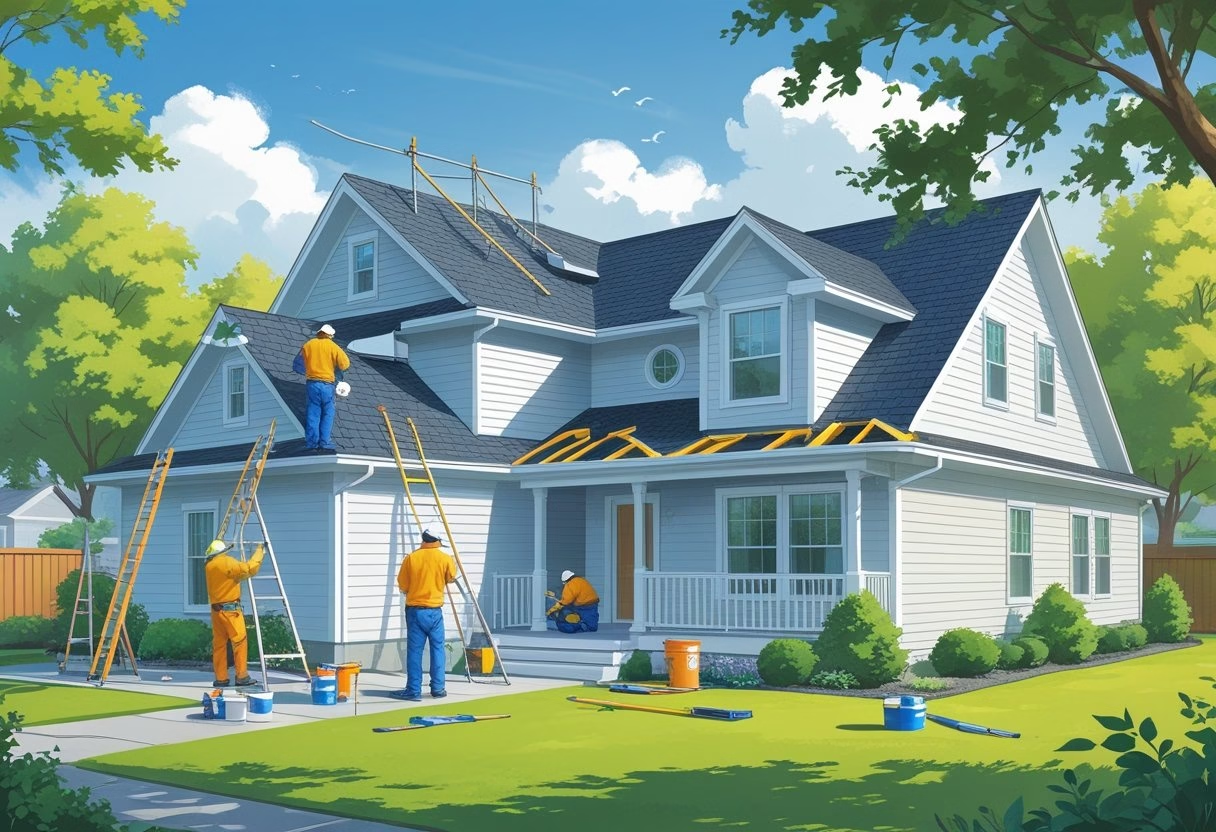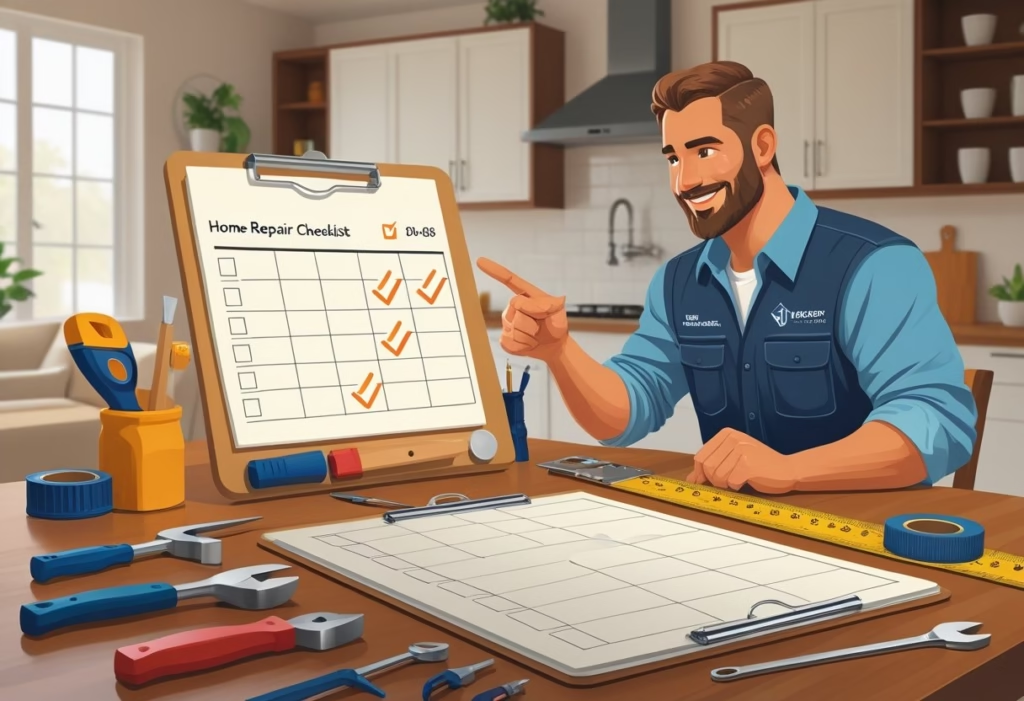Your home really does need regular attention if you want it to stay safe, comfortable, and, well, worth anything. Without a plan, it’s way too easy to miss important fixes—and that’s when the little stuff snowballs into some wallet-crushing nightmare.

A complete home repair checklist helps you prioritize what actually matters, schedule seasonal repairs, and figure out when to DIY or call in the pros. That kind of system keeps the chaos in check and helps your home run smoothly year-round.
The trick is figuring out what’s urgent and what can wait. Some fixes really do need a professional right away for safety’s sake. Others? You can probably handle those with a screwdriver and a YouTube video. Having the right info helps you make smarter choices for your home.
Key Takeaways
- Regular maintenance stops little issues from turning into expensive disasters
- Seasonal checklists keep you organized and on schedule
- Knowing when to DIY or call in help saves money and keeps things safe
Why Routine Home Maintenance Matters
Regular maintenance isn’t just about appearances—it stops small problems from turning into major headaches. You’ll save thousands in repairs and keep your property’s value solid.
Preventing Costly Repairs
Maintenance lets you catch issues early, when they’re cheap to fix. A tiny roof leak might cost $200. Ignore it, and now you’re looking at $10,000 in damage. Ouch.
Some prevention basics:
- Clean gutters to avoid water damage to your foundation
- Change HVAC filters so your system doesn’t quit on you
- Seal cracks to keep pests out
- Test smoke detectors to prevent fire disasters
Inspections help you spot warning signs. Replacing a loose shingle is easy. Waiting until the roof caves in? Not so much.
Most homeowners spend 1-3% of their home’s value each year on maintenance. That’s nothing compared to what you’d pay if you put things off.
Protecting Health and Safety
Maintenance isn’t just about money—it keeps you and your family safe. Electrical issues can start fires. Broken steps cause falls. Mold creeps in if you ignore leaks or poor ventilation.
Big safety priorities:
- Test carbon monoxide detectors
- Check electrical outlets
- Inspect stairs and railings
- Test water heater safety valves
Air quality depends on regular care. Dirty filters mean more allergens in the air. Clogged dryer vents? That’s a fire waiting to happen. Leaky pipes? Mold city.
Repairs seem to pick the worst times to show up. A furnace dying in winter puts everyone at risk. Staying on top of maintenance helps you avoid those emergencies.
Boosting Home Value
People pay more for homes that look cared for. If buyers see obvious problems, they’ll assume there are hidden ones too—and run for the hills.
Maintenance that protects value:
- Fresh paint and a clean exterior
- Working electrical and plumbing
- Efficient heating and cooling
- Solid roof and foundation
Appraisers notice when homes are neglected. Peeling paint and outdated systems drag down your property’s worth. Regular upkeep shows you care—and that matters.
Homes with good maintenance keep about 95% of their value over time. Neglected ones? They can lose 20% or more in just a few years.
Essential Interior Repairs and When to Address Them

Interior repairs keep your home safe and comfortable. Damaged walls need quick fixes to stop mold. Faulty detectors? Test those monthly, no excuses.
Drywall Damage and Repair
Small holes from nails or screws? Fix those right away with spackling compound. It’s a five-minute job.
Bigger holes call for a mesh patch or a new drywall piece. Cut out the damage, patch it, and use joint compound to finish up.
Cracks in walls often mean the foundation is settling. Hairline cracks can wait for seasonal repairs, but big cracks? Don’t wait—get on those now.
Water stains spell trouble. Find and fix the leak first. Then replace the damaged drywall completely.
| Damage Type | Timeline | DIY or Professional |
|---|---|---|
| Nail holes | Immediate | DIY |
| Large holes | Within 1 week | DIY/Professional |
| Water damage | Immediate | Professional |
| Foundation cracks | Immediate | Professional |
When drywall damage is bigger than 6 inches or you see mold, don’t wait—fix it urgently.
Flooring Issues and Quick Fixes
Squeaky floors can wait about a month, but don’t let them drive you nuts. Use screws through the subfloor into the joists to stop the noise.
Loose tiles are trip hazards and let moisture in. Re-glue them within two weeks or risk water damage.
Scratched hardwood isn’t urgent unless the scratch goes through the finish. Then, it’s time to refinish or repair.
Carpet stains need fast action—blot liquids right away and use the right cleaner for the stain.
Buckling laminate means there’s moisture somewhere. Fix the leak and swap out the damaged planks within a week.
Check high-traffic areas every month for loose boards or tiles. Spring and fall work best for big flooring repairs when humidity is low.
Plumbing Problems: Toilets and Faucets
Running toilets waste a ton of water—up to 200 gallons a day! Fix them within 48 hours by replacing the flapper or adjusting the chain.
Leaky faucets need attention right away. Swap out the washers or cartridges before you get a big water bill.
Toilet clogs can’t wait. Grab a plunger or snake and clear the blockage before it overflows.
Low water pressure is usually a clogged aerator. Clean it with vinegar every month to keep things flowing.
If your toilet rocks or moves, install a new wax ring immediately. That keeps sewer gas and water from leaking out.
Call a plumber for:
- Sewer backups
- No hot water
- Multiple drain clogs
- Water heater problems
Electrical Safety: Smoke and Carbon Monoxide Detectors
Smoke detectors need a monthly test—just press the button. Change batteries twice a year, maybe when you change the clocks.
Carbon monoxide detectors work the same way. Test them monthly—they can literally save your life.
If a detector chirps, it means low batteries. Replace them right away. Don’t ignore that sound.
Detectors older than 10 years? Replace them with new ones. Modern units are more sensitive and last longer.
Install detectors:
- Outside every bedroom
- On each floor
- In basements and attics
- Near anything that burns fuel
If a detector fails its monthly test, swap it out immediately. These devices really do prevent deaths.
Get in the habit: test all detectors on the first Sunday of each month. Put a reminder on your phone or calendar.
Exterior and Structural Repairs for Home Protection

Your home’s exterior stands between you and the weather. If you keep up with gutters, roofs, siding, and entry points, you’ll dodge a lot of expensive headaches.
Gutter Cleaning and Maintenance
Clean your gutters twice a year—usually spring and fall. If you let them clog, water will overflow and wreck your foundation, siding, and even your landscaping.
Use your hands or a trowel to scoop out leaves and debris. Then run a hose through the downspouts to make sure water flows freely.
Watch for these gutter problems:
- Sagging spots
- Loose brackets
- Rust or holes
- Water stains on outside walls
If gutters sag, add new brackets for support. Patch small holes with roofing cement. Big damage? Time to call in a pro for replacement.
Make sure gutters slope the right way so water heads to the downspouts, not pooling in the middle.
Roof Inspection and Repair
Check your roof from the ground with binoculars every six months. Look for missing, cracked, or curled shingles that could let water in.
What to check:
- Shingle condition and alignment
- Flashing around vents and chimneys
- Gutter attachment points
- Moss or algae growth
Replacing a missing shingle is pretty simple and takes about 10 minutes. But if you see a lot of damage or leaks, get a professional to check it out.
Walking on your roof is risky and can make things worse, so don’t unless you really know what you’re doing.
Pay attention to vent flashing. When caulk fails around vent pipes, water sneaks in and can ruin your ceilings and walls.
Siding and Caulking Checks
Inspect your siding once a year for cracks, loose boards, or rot. Wood siding usually starts to rot at ground level where water collects.
Fill small cracks with exterior wood filler. Tighten loose boards with screws—they hold better than nails.
Check caulk around:
- Windows and doors
- Corner joints
- Where siding meets the foundation
- Utility entry points
Old caulk gets brittle and peels away. Pull it out completely before applying new caulk.
Use a high-quality exterior caulk that matches your siding material. If you prep the surface right, the new caulk will last longer.
If you find rotten siding boards, replace them. If there’s a lot of rot, you might have a bigger structural problem—probably time for a pro to take a look.
Windows and Doors: Seals and Hardware
Check the weatherstripping around exterior doors and windows every fall, before the cold sets in. Damaged seals let out precious heat and invite moisture inside—nobody wants that.
To test door seals, close the door and look for any light sneaking through. If you spot gaps, swap out the old weatherstripping for self-adhesive foam or rubber strips (they’re easy to find at hardware stores).
Window hardware works best with a bit of love once a year. Clean out the tracks, then hit the moving parts with a spray of silicone.
Door maintenance tasks:
- Adjust hinges and strike plates
- Lubricate locks and handles
- Check door frame alignment
- Replace worn threshold seals
Storm doors need regular attention, too. Make sure the closers work right and the screens haven’t torn or popped loose.
If you’re installing a new exterior door—especially if you’re changing the size—sometimes it’s just better to call in a pro. Good installation keeps out the weather and keeps your place secure.
Appliances and Essential Home Systems
Your home’s big systems and appliances need some regular TLC if you want them to last. Water heaters need a flush once a year, HVAC filters need swapping every few months, and kitchen appliances run smoother when you keep them clean.
Water Heater Maintenance
Most water heaters stick around for about 8-12 years if you treat them right. Every six months, check for rust or leaks around the base—just a quick look can save a headache later.
Annual flushing clears out sediment that piles up inside the tank. Shut off the power or gas, hook up a hose to the drain valve, and let it run until the water’s clear. This keeps things efficient and helps prevent corrosion.
Temperature settings should hang out at 120°F. Any higher and you’re wasting energy (and risking burns); too low, and you might not kill bacteria.
Anode rods fight rust inside the tank. Swap them out every 3-5 years. If you’re not sure, a plumber can check for you.
Gas units need good ventilation. Make sure the flue pipe connects tightly and doesn’t show rust or damage. For electric units, double-check those electrical connections.
If your water heater starts making odd noises—like popping or rumbling—sediment is probably to blame. If flushing doesn’t quiet things down, it’s time to call in a pro.
HVAC System Upkeep
HVAC systems run all year and need a little attention to keep up. Change air filters every 1-3 months based on how much you use them and the filter type.
Dirty filters force the system to work harder and tank your air quality. Clean vents and ducts help air move freely, so dust off supply and return vents monthly.
Get your ducts cleaned professionally every 3-5 years to clear out the deep-down gunk. Outdoor units need space—clear out leaves, grass, and junk within two feet.
If the fins are bent, use a fin comb to straighten them gently (don’t rush this part). Thermostat batteries should get swapped out once a year, and programming your thermostat saves energy when you’re away.
Have a pro service the system twice a year—once before summer, once before winter. They’ll check refrigerant, clean coils, and spot problems before they get expensive.
Appliance Cleaning and Inspection
Kitchen appliances take a beating. Refrigerator coils get dusty and make the motor work overtime, so clean them every six months with a brush or vacuum.
Dishwasher filters trap food and need a monthly rinse. Pop out the bottom rack, unscrew the filter, and scrub it under hot water.
Oven door seals keep heat where it belongs. Wipe them clean and check for cracks or tears—replace them if they’re looking rough.
Washing machine hoses deserve a look-over every few months. If you see bulges, cracks, or rust, swap them out. Even if hoses look fine, replace them every five years.
Dryer vents need to stay clear to avoid fires. Clean the lint trap after every load, and check the outside vent every few months for blockages.
Don’t ignore small appliances. Run vinegar through your coffee maker monthly to clear mineral buildup, and empty toaster crumb trays weekly (unless you like the smell of burnt crumbs).
Seasonal Home Repair Checklist
Every season brings its own set of home headaches. Keeping up with seasonal tasks helps you dodge bigger repairs and keeps things humming along.
Spring and Summer Maintenance
Spring is the unofficial start of home maintenance season. Start with a good look around the outside after winter’s done its thing.
Roof and Gutters
- Check for loose or damaged shingles
- Give gutters a thorough cleaning—get rid of leaves and muck
- Inspect downspouts for good drainage
- Look for ice damage around the roof edges
HVAC System
Spring’s a great time to service your AC. Change the filters and clean the vents before the heat hits.
Exterior Tasks
- Wash windows and screens
- Check deck railings and boards for damage
- Test outdoor faucets for freeze damage
- Trim trees away from the house
Summer Focus Areas
The heat can stress your home’s systems. Check attic insulation and make sure you’ve got good ventilation.
Look over caulking around windows and doors. Test sprinklers and check for leaks. After a summer storm, walk around and look for siding damage—catching it early makes repairs easier.
Fall Preparation
Fall is all about getting ready for the cold. This season’s to-do list tends to be the longest.
Heating System
- Schedule a furnace inspection and cleaning
- Replace furnace filters
- Test carbon monoxide detectors
- Check the fireplace and chimney if you have them
Weatherproofing
Seal up gaps around windows and doors with fresh caulk. Add weatherstripping as needed. Check insulation in the attic.
Outdoor Preparations
- Clean gutters again after the leaves drop
- Disconnect and drain garden hoses
- Shut off outdoor water valves
- Store patio furniture
Roof and Siding
Look for loose materials that winter could rip off. Check for spots where critters might sneak in and seal them up.
Winterizing Your Home
Winter is all about stopping freeze damage and keeping things cozy inside.
Plumbing Protection
Insulate pipes in cold spots like basements and crawl spaces. Know where your main water shut-off lives—just in case.
Emergency Preparedness
- Keep flashlights and batteries handy
- Test backup heating sources (safely!)
- Clear snow from vents and exhaust pipes
- Check your emergency supplies
Indoor Air Quality
With windows closed, air gets stale. Change HVAC filters more often and use fans to keep things moving.
Regular Checks
Watch for ice dams on the roof. Keep heating vents clear of furniture. Test smoke and carbon monoxide detectors every month.
DIY or Professional Help: Who to Call for Home Repairs
Some home fixes are perfect for a weekend DIY session, but others? Not so much. The trick is knowing what matches your skills and what’s better left to the pros.
Which Repairs You Can Tackle Yourself
Simple repairs are doable for most folks with basic tools and a bit of patience. These projects don’t need special permits or expert know-how.
Painting is a classic DIY job. You just need brushes, rollers, and some drop cloths. Picking the right paint is usually the hardest part.
Installing shelves is straightforward—grab a drill, level, and wall anchors. Most people can put up floating shelves or brackets in under an hour.
Basic plumbing fixes like swapping out faucets, stopping a running toilet, or unclogging drains just take simple tools and a little time.
Light fixture changes are usually safe if you keep the electrical box the same. Always cut the power at the breaker and match wire colors.
Minor repairs like patching drywall holes, caulking windows, and replacing door handles don’t take much experience.
When to Hire Home Repair Services
Safety risks mean you should call in a pro. Electrical work beyond simple switches can cause fires—or worse.
Major plumbing like moving pipes or fixing main lines needs a licensed plumber. Water damage from mistakes gets expensive fast.
Structural changes (moving walls, adding rooms) need engineers and contractors who know the codes. Don’t risk your home’s safety.
Roof repairs are risky—falls happen, and hidden damage is easy to miss. Roofers have the safety gear and know-how.
HVAC work involves gas, electricity, and complex systems. Messing up can lead to carbon monoxide leaks or system breakdowns.
Permit requirements are a big clue—if your city says you need a licensed contractor, don’t DIY it. Electrical, plumbing, and structural work usually fall into this category.
Finding the Right Professional
Check credentials before hiring anyone. Look up licenses on your state’s website and make sure their insurance covers accidents.
Read reviews on Google, Yelp, and the BBB. Watch for patterns—if lots of people complain about the same thing, that’s a red flag.
Get quotes from at least three repair services. Compare prices, timelines, materials, and what kind of warranty they offer.
Ask for references from recent clients. Good contractors are happy to share contact info for people who can vouch for their work.
Review contracts carefully. Make sure they list the work, materials, costs, and completion dates. If someone wants full payment upfront, walk away.
Verify permits will be handled. Professional contractors take care of paperwork and inspections for big jobs.
Frequently Asked Questions
Homeowners ask a lot about maintenance schedules and when to call in the pros. Weekly routines are all about quick checks, while monthly ones focus on bigger systems like HVAC and plumbing.
What tasks should be included in a weekly home maintenance routine?
Weekly maintenance should cover the basics. Test smoke detectors and carbon monoxide alarms every week to make sure they work.
Look for water leaks around faucets, toilets, and appliances—catching them early is key. Give your electrical outlets a quick look for damage or loose connections.
Clear out dryer lint and check that air vents aren’t blocked. These jobs only take a few minutes but can save you a ton of trouble down the line.
How often should major home appliances be serviced to avoid costly repairs?
HVAC systems really need a professional checkup twice a year—once before heating season, then again before cooling kicks in. That way, you’re less likely to deal with a breakdown when the weather’s wild and repair bills spike.
Water heaters should get inspected every year, and it’s smart to flush them to clear out sediment. If you bring in a pro every couple of years, you’ll probably squeeze a few extra years out of the unit.
Refrigerators and washing machines work better if you clean their coils and filters once a year. Dishwashers? Take a look for leaks every six months—just in case.
What are some essential monthly maintenance checks for a well-maintained home?
Each month, swap out furnace filters to keep air clean and your system running smoothly. Dirty filters? They’ll hike up your energy bill and make your HVAC work harder than it should.
Test all your ground-fault circuit interrupters every month. For garbage disposals, toss in some ice cubes and baking soda to keep smells and clogs away.
Check the salt in your water softener, and peek at your tub and sink drains for any gunk. All these little jobs add up—maybe two hours a month, tops.
Which home repairs should be prioritized for safety and long-term savings?
If you spot worn cords or a sketchy outlet, fix it right away—electrical stuff isn’t worth the risk. Loose shingles? Patch them up fast before water sneaks in.
Plumbing leaks waste water and can quietly wreck your house if you ignore them. Sealing up gaps around windows and doors helps cut down on those annoying energy bills.
Don’t put off HVAC repairs—they’ll save you hassle and cash in the long run. If you see cracks in your foundation, seal them up early to dodge bigger headaches later.
What are some critical annual maintenance tasks to ensure home longevity?
Get your HVAC system inspected and cleaned by a pro every year. It keeps things running right and helps you avoid surprise breakdowns.
Have someone check your chimney and fireplace to steer clear of fire hazards and carbon monoxide problems. For the roof, look for missing or busted shingles so water doesn’t creep in.
Clean and repair gutters to keep your foundation dry. Pump your septic system every three to five years, or you could end up with a nasty backup.
Flush your water heater once a year to get rid of sediment and keep it working better, longer.
Who should be contacted for professional home repairs when DIY is not advisable?
Call a licensed electrician for anything beyond swapping out an outlet. Electrical mistakes? Those can lead to fires or even electrocution—definitely not worth the risk.
For major pipe repairs, water heater installs, or sewer line trouble, you’ll want a plumber on the job. And when it comes to gas lines, don’t even think about DIY—let a licensed pro handle it.
HVAC technicians should take care of heating and cooling systems. If you mess with it yourself, you might void the warranty, and that’s just a headache.
Steep roof repairs or anything structural? Roofing contractors have the gear and know-how to do it safely.

